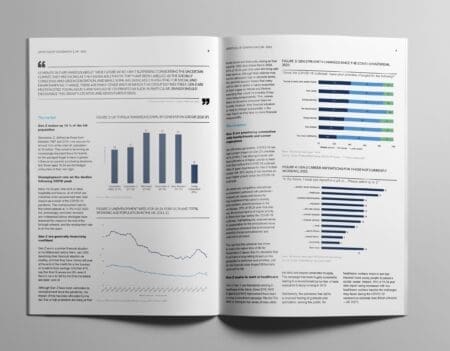A new type of restaurant is starting to emerge in the US foodservice industry; one that marries the convenience of fast casuals with the food found at a fine dining restaurant. These restaurants (often called fast fine, fast casual premium, or fast casual 2.0) typically feature a full bar, a large menu and serve high quality meals without a waiter.
What does this trend mean for the US foodservice industry? Mintel’s foodservice analysts share their views:
 Amanda Topper, Associate Director of Foodservice Research
Amanda Topper, Associate Director of Foodservice Research
This trend of fine dining becoming more casual makes a lot of sense from an operational perspective. Rising labor costs in the US, coupled with the increasing cost of dining out (especially compared to the price of food for at-home consumption) are placing a lot of pressure on operators to streamline costs. By simplifying or automating the ordering process, more attention and resources can be directed toward obtaining quality ingredients and menu item execution. Additionally, reduced labor costs – a byproduct of limiting the number of staff – can help maintain profitability for operators. However, having some employees in the dining room for refills, bussing tables or answering questions, can help patrons still feel taken care of.
While these operational shifts can improve efficiency and convenience, and reduce costs, the emphasis on the dining experience is still fundamentally important. As Mintel’s 2017 US Foodservice trend The Experience Dichotomy explains, diners are on the hunt for new experiences and restaurants are offering patrons unique and memorable meals. Ambiance, including décor and music, should be just as calculated as each component of the menu. Although affordability will remain important, diners shouldn’t feel like they have to sacrifice quality or experience when dining at a fast fine restaurant.
 Diana Kelter, Foodservice Analyst
Diana Kelter, Foodservice Analyst
The emergence of disruptive dining segments is not a new revelation in the foodservice industry. The fast casual segment was originally created by offering the convenience of fast food with premium ingredients. While launching something completely unexpected can be somewhat of a risk, combining elements that consumers value from different segments is often a sweet spot. The “fast fine” concept specifically caters to Millennials, a generation that has carved out dining preferences drastically different from their older counterparts.
Millennials place increased value on experiences, both small and large, and as a result they’re often putting off larger purchases until later in life in favor of smaller indulgences, such as dining out, more frequently. With fine dining being the ultimate leader in experience based dining, the trickle down effect to “fast fine” offers consumers the broader aspects they value from fine dining, just at a more affordable, any occasion, price point. However, this segment poses a stronger threat to casual dining restaurants compared to traditional fine dining segments.
 Caleb Bryant, Senior Foodservice Analyst
Caleb Bryant, Senior Foodservice Analyst
The fine dining segment has evolved over the years. Once servers wore jackets and white gloves, now they can wear jeans and have tattoos. Many things have changed, yet one thing has remained the same, an emphasis on great service. Servers can make or break a restaurant and removing the server from the fine dining restaurant takes away from the entire dining experience. While there certainly has been a casualization of fine dining, these new “fast fine” restaurants may be fast but they are not fine. Something is lost when a plastic buzzer tells you to pick up your food, no matter how fancy the dish is. The restaurant industry has been plagued by market saturation and increasing costs, making this ‘fast fine’ service model appealing for operators. However, these new restaurants are simply the next step for fast casuals and do not replace the fine dining experience.
Amanda Topper is the Associate Director of Foodservice Research, responsible for overseeing all of Mintel’s foodservice offerings, as well as providing insight and competitive analysis across scheduled deliverables, and client and industry presentations. She was previously a Senior Analyst specializing in the retail food industry.
Diana Kelter is a Foodservice Analyst at Mintel. Diana authors reports focusing on changing consumer attitudes, industry news, and flavor / ingredient trends within foodservice. Diana also specializes in leveraging menu data from Mintel Menu Insights database.
Caleb Bryant is a Senior Foodservice Analyst at Mintel. Caleb authors reports focusing on changing consumer attitudes, industry news and flavor/ingredient trends within foodservice.












 Amanda Topper, Associate Director of Foodservice Research
Amanda Topper, Associate Director of Foodservice Research Diana Kelter, Foodservice Analyst
Diana Kelter, Foodservice Analyst Caleb Bryant, Senior Foodservice Analyst
Caleb Bryant, Senior Foodservice Analyst


























